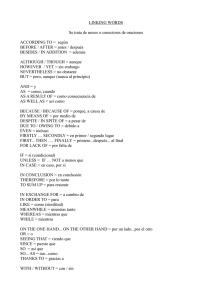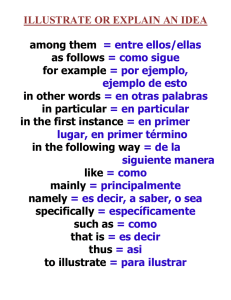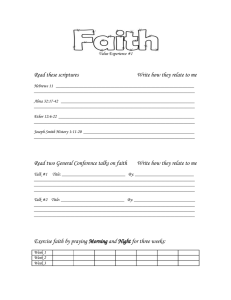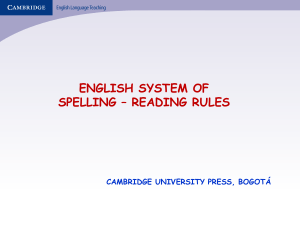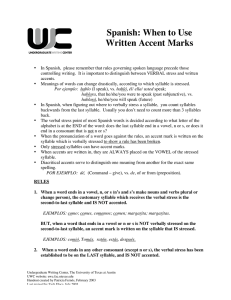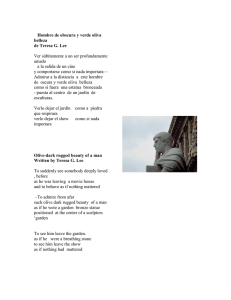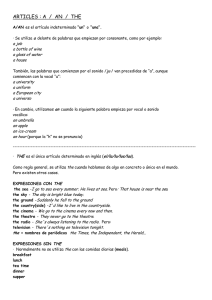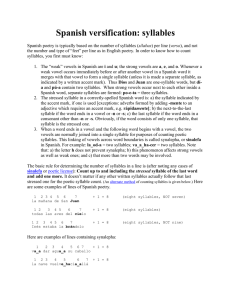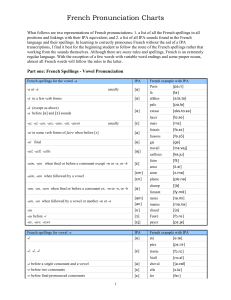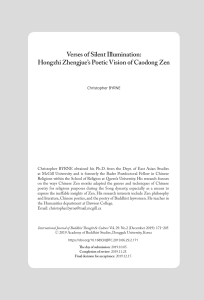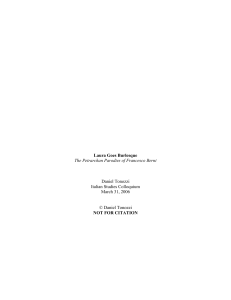Spanish Poetic Terms
Anuncio
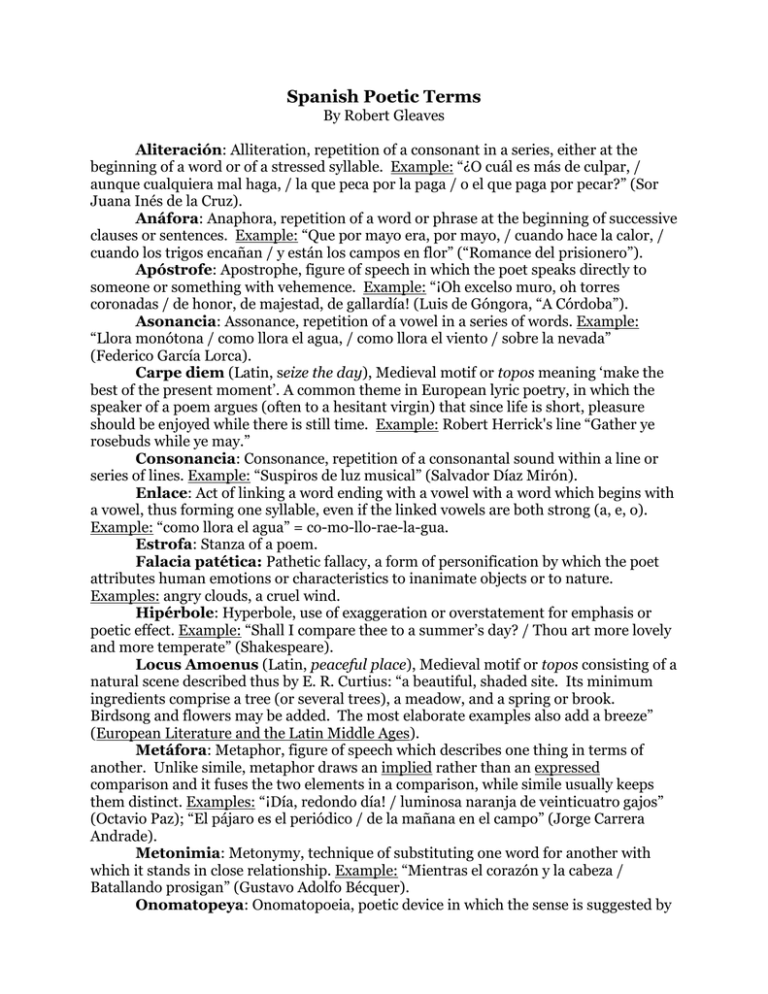
Spanish Poetic Terms By Robert Gleaves Aliteración: Alliteration, repetition of a consonant in a series, either at the beginning of a word or of a stressed syllable. Example: “¿O cuál es más de culpar, / aunque cualquiera mal haga, / la que peca por la paga / o el que paga por pecar?” (Sor Juana Inés de la Cruz). Anáfora: Anaphora, repetition of a word or phrase at the beginning of successive clauses or sentences. Example: “Que por mayo era, por mayo, / cuando hace la calor, / cuando los trigos encañan / y están los campos en flor” (“Romance del prisionero”). Apóstrofe: Apostrophe, figure of speech in which the poet speaks directly to someone or something with vehemence. Example: “¡Oh excelso muro, oh torres coronadas / de honor, de majestad, de gallardía! (Luis de Góngora, “A Córdoba”). Asonancia: Assonance, repetition of a vowel in a series of words. Example: “Llora monótona / como llora el agua, / como llora el viento / sobre la nevada” (Federico García Lorca). Carpe diem (Latin, seize the day), Medieval motif or topos meaning ‘make the best of the present moment’. A common theme in European lyric poetry, in which the speaker of a poem argues (often to a hesitant virgin) that since life is short, pleasure should be enjoyed while there is still time. Example: Robert Herrick's line “Gather ye rosebuds while ye may.” Consonancia: Consonance, repetition of a consonantal sound within a line or series of lines. Example: “Suspiros de luz musical” (Salvador Díaz Mirón). Enlace: Act of linking a word ending with a vowel with a word which begins with a vowel, thus forming one syllable, even if the linked vowels are both strong (a, e, o). Example: “como llora el agua” = co-mo-llo-rae-la-gua. Estrofa: Stanza of a poem. Falacia patética: Pathetic fallacy, a form of personification by which the poet attributes human emotions or characteristics to inanimate objects or to nature. Examples: angry clouds, a cruel wind. Hipérbole: Hyperbole, use of exaggeration or overstatement for emphasis or poetic effect. Example: “Shall I compare thee to a summer’s day? / Thou art more lovely and more temperate” (Shakespeare). Locus Amoenus (Latin, peaceful place), Medieval motif or topos consisting of a natural scene described thus by E. R. Curtius: “a beautiful, shaded site. Its minimum ingredients comprise a tree (or several trees), a meadow, and a spring or brook. Birdsong and flowers may be added. The most elaborate examples also add a breeze” (European Literature and the Latin Middle Ages). Metáfora: Metaphor, figure of speech which describes one thing in terms of another. Unlike simile, metaphor draws an implied rather than an expressed comparison and it fuses the two elements in a comparison, while simile usually keeps them distinct. Examples: “¡Día, redondo día! / luminosa naranja de veinticuatro gajos” (Octavio Paz); “El pájaro es el periódico / de la mañana en el campo” (Jorge Carrera Andrade). Metonimia: Metonymy, technique of substituting one word for another with which it stands in close relationship. Example: “Mientras el corazón y la cabeza / Batallando prosigan” (Gustavo Adolfo Bécquer). Onomatopeya: Onomatopoeia, poetic device in which the sense is suggested by the sounds of the words used. Examples: “The moan of doves in immemorial elms, / And murmuring of innumerable bees” (Tennyson); “En el silencio sólo se escuchaba / Un susurro de abejas que sonaba” (Garcilaso). Oxímoro: Oxymoron, paradoxical statement which combines two words or phrases usually considered contraries. Example: “Parting is such sweet sorrow” (Shakespeare). Personificación: Personification, figure of speech which attributes human qualities to inanimate or abstract things. Example: “El día se suicida / arrojándose al mar” (Vicente Huidobro). Rima asonante: Assonantal rhyme, patterned repetition of vowels at the end of a poetic line, beginning with the last accented vowel. Examples: plácido <-> tocando <-> campanario; redondos <-> oro <-> olmo. Rima consonante: Consonantal rhyme, patterned repetition of vowels and consonants at the end of a poetic line, beginning with the last accented vowel. Examples: tesoro <-> lloro; volver <-> querer. Silepsis / Zeugma: Syllepsis, construction in which one word is used to modify or govern two or more words, often so that its use is grammatically or logically correct with only one. Examples: “He lost his hat and his temper;” “Pasó un perro, pasó una monja, / pasó una semana y un año” (Neruda). Símbolo: Symbol, metaphor from which the first term has been omitted. The rose is a symbol if it represents a beautiful girl, but if we say that a girl is a rose, we are emphasizing metaphorical transfer from one object to another. Example: “And I have seen the eternal Footman hold my coat and snicker / And in short, I was afraid” (T. S. Eliot). Símil: Simile, figure of speech which compares one thing directly with another, usually with the linking word como (like or as). Example: “El verano, redondo como una sandía” (Neruda). Sílaba: Syllable of a word. Sinestesia: Synesthesia, metaphorical description of one of the five senses by means of evoking another of those senses (dry martini, sweet smile, sour note, bitter sight, loud shirt, cold words, warm color). Example: “Y un horizonte de perros / ladra muy lejos del río” (García Lorca). Ubi sunt?: (Latin, where are they?), Medieval motif or topos used to convey sadness about the temporary nature of life and beauty. Example: “Where are the snows of yesteryear?” (Francois Villon). Verso: Verse in general, or an individual line of poetry. Verso agudo: Poetic line with stress on the last syllable. Example: “Onda de luz”. Verso esdrújulo: Poetic line with stress on the third-to-last syllable. Example: “Cantan los pájaros” Verso llano: Poetic line with stress on the next-to-last syllable. Example: “Ya lo comprendo”. Versos impares: Odd-numbered poetic lines (1, 3, 5, etc.). Versos pares: Even-numbered poetic lines (2, 4, 6, etc.). Updated February 25, 2008
